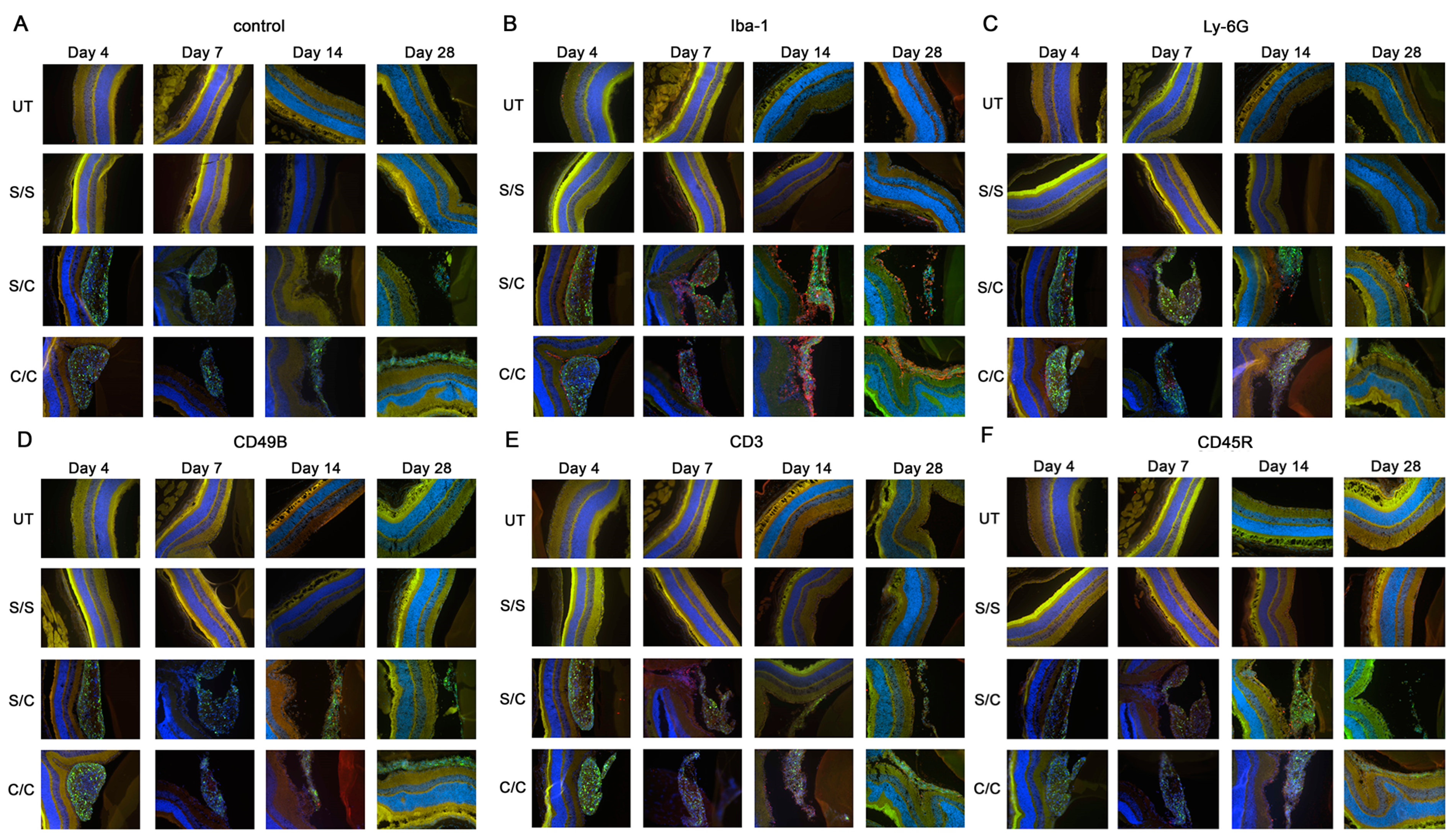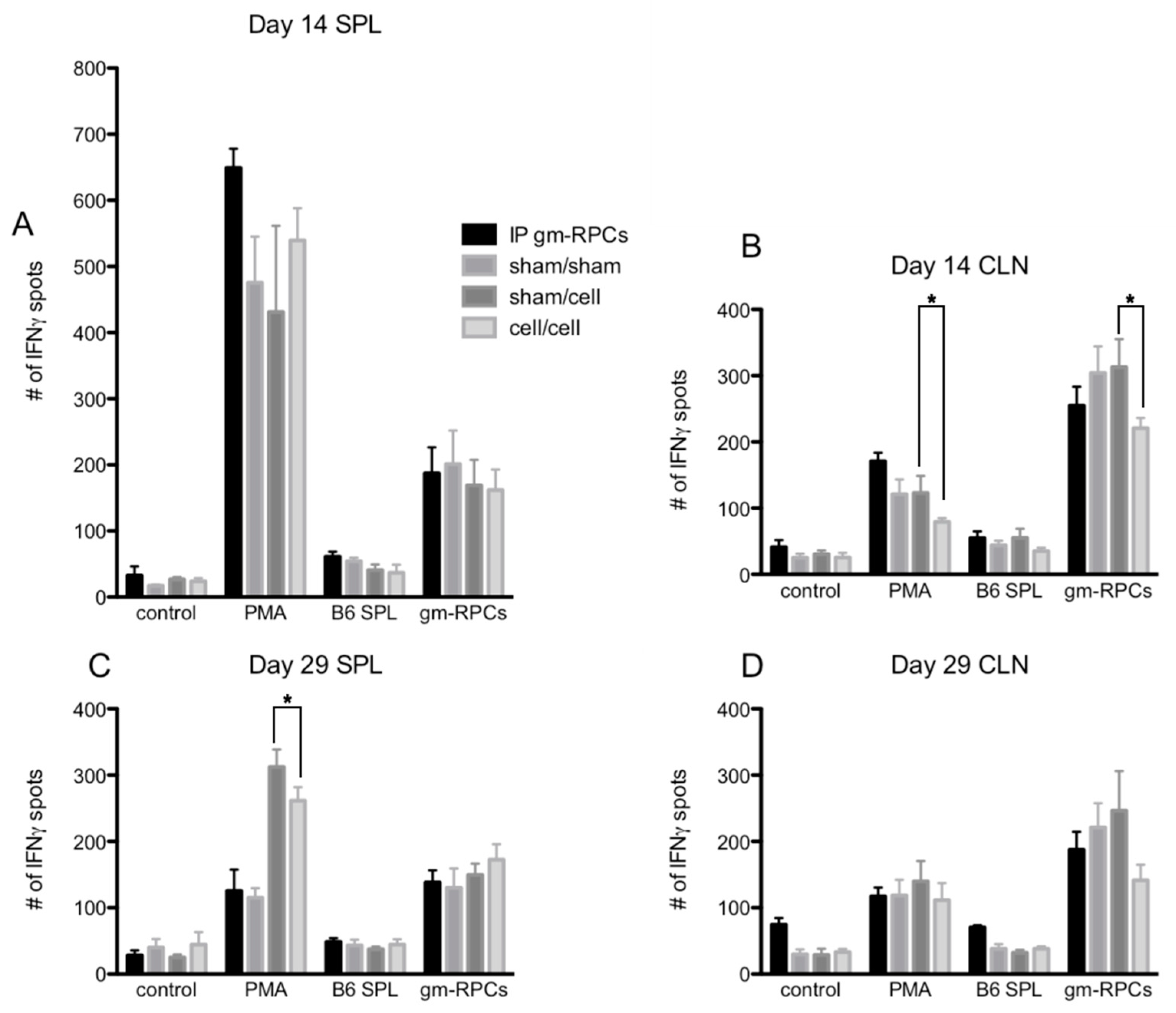Immune Responses to Sequential Binocular Transplantation of Allogeneic Retinal Progenitor Cells to the Vitreous Cavity in Mice
Abstract
:1. Introduction
2. Results
2.1. Clinical Observation and Ophthalmic Examination Revealed No Abnormalities
2.2. Immunofluorescent Labeling Showed Immune Cells in the Vitreous
2.3. ELISPOT Did Not Show Antigen Recall Responses
3. Discussion
4. Materials and Methods
4.1. Cell Culture
4.2. Experimental Animals
4.3. Intravitreal Injection
4.4. Ophthalmic Examination
4.5. Histopathology
4.6. ELISPOT and MLR Assays
5. Conclusions
Author Contributions
Funding
Institutional Review Board Statement
Informed Consent Statement
Acknowledgments
Conflicts of Interest
References
- Hori, J.; Ng, T.F.; Shatos, M.; Klassen, H.; Streilein, J.W.; Young, M.J. Neural progenitor cells lack immunogenicity and resist destruction as allografts. Stem Cells 2003, 21, 405–416. [Google Scholar] [CrossRef] [PubMed] [Green Version]
- Klassen, H.; Schwartz, P.H.; Ziaeian, B.; Nethercott, H.; Young, M.J.; Bragadottir, R.; Tullis, G.E.; Warfvinge, K.; Narfstrom, K. Neural precursors isolated from the developing cat brain show retinal integration following transplantation to the retina of the dystrophic cat. Vet. Ophthalmol. 2007, 10, 245–253. [Google Scholar] [CrossRef] [PubMed]
- Salado-Manzano, C.; Perpina, U.; Straccia, M.; Molina-Ruiz, F.J.; Cozzi, E.; Rosser, A.E.; Canals, J.M. Is the Immunological Response a Bottleneck for Cell Therapy in Neurodegenerative Diseases? Front. Cell Neurosci. 2020, 14, 250. [Google Scholar] [CrossRef]
- Petrus-Reurer, S.; Romano, M.; Howlett, S.; Jones, J.L.; Lombardi, G.; Saeb-Parsy, K. Immunological considerations and challenges for regenerative cellular therapies. Commun. Biol. 2021, 4, 798. [Google Scholar] [CrossRef]
- Bucher, K.; Rodriguez-Bocanegra, E.; Dauletbekov, D.; Fischer, M.D. Immune responses to retinal gene therapy using adeno-associated viral vectors—Implications for treatment success and safety. Prog. Retin. Eye Res. 2021, 83, 100915. [Google Scholar] [CrossRef]
- Singh, M.S.; Park, S.S.; Albini, T.A.; Canto-Soler, M.V.; Klassen, H.; MacLaren, R.E.; Takahashi, M.; Nagiel, A.; Schwartz, S.D.; Bharti, K. Retinal stem cell transplantation: Balancing safety and potential. Prog. Retin. Eye Res. 2020, 75, 100779. [Google Scholar] [CrossRef]
- Kamao, H.; Mandai, M.; Okamoto, S.; Sakai, N.; Suga, A.; Sugita, S.; Kiryu, J.; Takahashi, M. Characterization of human induced pluripotent stem cell-derived retinal pigment epithelium cell sheets aiming for clinical application. Stem Cell Rep. 2014, 2, 205–218. [Google Scholar] [CrossRef] [Green Version]
- Sugita, S.; Kamao, H.; Iwasaki, Y.; Okamoto, S.; Hashiguchi, T.; Iseki, K.; Hayashi, N.; Mandai, M.; Takahashi, M. Inhibition of T-cell activation by retinal pigment epithelial cells derived from induced pluripotent stem cells. Investig. Ophthalmol. Vis. Sci. 2015, 56, 1051–1062. [Google Scholar] [CrossRef]
- McGill, T.J.; Stoddard, J.; Renner, L.M.; Messaoudi, I.; Bharti, K.; Mitalipov, S.; Lauer, A.; Wilson, D.J.; Neuringer, M. Allogeneic iPSC-Derived RPE Cell Graft Failure Following Transplantation Into the Subretinal Space in Nonhuman Primates. Investig. Ophthalmol. Vis. Sci. 2018, 59, 1374–1383. [Google Scholar] [CrossRef] [Green Version]
- Sugita, S.; Mandai, M.; Kamao, H.; Takahashi, M. Immunological aspects of RPE cell transplantation. Prog. Retin. Eye Res. 2021, 84, 100950. [Google Scholar] [CrossRef]
- Nair, D.S.R.; Thomas, B.B. Stem Cell-based Treatment Strategies for Degenerative Diseases of the Retina. Curr. Stem Cell Res. Ther. 2022, 17, 214–225. [Google Scholar] [CrossRef] [PubMed]
- Martinez Velazquez, L.A.; Ballios, B.G. The Next Generation of Molecular and Cellular Therapeutics for Inherited Retinal Disease. Int. J. Mol. Sci. 2021, 22, 11542. [Google Scholar] [CrossRef]
- Liu, Y.; Chen, S.J.; Li, S.Y.; Qu, L.H.; Meng, X.H.; Wang, Y.; Xu, H.W.; Liang, Z.Q.; Yin, Z.Q. Long-term safety of human retinal progenitor cell transplantation in retinitis pigmentosa patients. Stem Cell Res. Ther. 2017, 8, 209. [Google Scholar] [CrossRef] [PubMed] [Green Version]
- Wang, Y.; Tang, Z.; Gu, P. Stem/progenitor cell-based transplantation for retinal degeneration: A review of clinical trials. Cell Death Dis. 2020, 11, 793. [Google Scholar] [CrossRef] [PubMed]
- German, O.L.; Vallese-Maurizi, H.; Soto, T.B.; Rotstein, N.P.; Politi, L.E. Retina stem cells, hopes and obstacles. World J. Stem Cells 2021, 13, 1446–1479. [Google Scholar] [CrossRef]
- Karamali, F.; Behtaj, S.; Babaei-Abraki, S.; Hadady, H.; Atefi, A.; Savoj, S.; Soroushzadeh, S.; Najafian, S.; Nasr Esfahani, M.H.; Klassen, H. Potential therapeutic strategies for photoreceptor degeneration: The path to restore vision. J. Transl. Med. 2022, 20, 572. [Google Scholar] [CrossRef]
- Semo, M.; Haamedi, N.; Stevanato, L.; Carter, D.; Brooke, G.; Young, M.; Coffey, P.; Sinden, J.; Patel, S.; Vugler, A. Efficacy and Safety of Human Retinal Progenitor Cells. Transl. Vis. Sci. Technol. 2016, 5, 6. [Google Scholar] [CrossRef]
- Mochizuki, M.; Sugita, S.; Kamoi, K. Immunological homeostasis of the eye. Prog. Retin. Eye Res. 2013, 33, 10–27. [Google Scholar] [CrossRef]
- Yamasaki, S.; Sugita, S.; Horiuchi, M.; Masuda, T.; Fujii, S.; Makabe, K.; Kawasaki, A.; Hayashi, T.; Kuwahara, A.; Kishino, A.; et al. Low Immunogenicity and Immunosuppressive Properties of Human ESC- and iPSC-Derived Retinas. Stem Cell Rep. 2021, 16, 851–867. [Google Scholar] [CrossRef]
- Klassen, H.; Schwartz, M.R.; Bailey, A.H.; Young, M.J. Surface markers expressed by multipotent human and mouse neural progenitor cells include tetraspanins and non-protein epitopes. Neurosci. Lett. 2001, 312, 180–182. [Google Scholar] [CrossRef]
- Klassen, H.; Ziaeian, B.; Kirov, I.I.; Young, M.J.; Schwartz, P.H. Isolation of retinal progenitor cells from post-mortem human tissue and comparison with autologous brain progenitors. J. Neurosci. Res. 2004, 77, 334–343. [Google Scholar] [CrossRef]
- Ingulli, E. Mechanism of cellular rejection in transplantation. Pediatr. Nephrol. 2010, 25, 61–74. [Google Scholar] [CrossRef] [Green Version]
- Issa, F.; Schiopu, A.; Wood, K.J. Role of T cells in graft rejection and transplantation tolerance. Expert Rev. Clin. Immunol. 2010, 6, 155–169. [Google Scholar] [CrossRef] [PubMed]
- Nasr, M.; Sigdel, T.; Sarwal, M. Advances in diagnostics for transplant rejection. Expert Rev. Mol. Diagn. 2016, 16, 1121–1132. [Google Scholar] [CrossRef] [PubMed] [Green Version]
- Klassen, H.; Imfeld, K.L.; Ray, J.; Young, M.J.; Gage, F.H.; Berman, M.A. The immunological properties of adult hippocampal progenitor cells. Vis. Res. 2003, 43, 947–956. [Google Scholar] [CrossRef] [PubMed] [Green Version]
- Weinger, J.G.; Weist, B.M.; Plaisted, W.C.; Klaus, S.M.; Walsh, C.M.; Lane, T.E. MHC mismatch results in neural progenitor cell rejection following spinal cord transplantation in a model of viral-induced demyelination. Stem Cells 2012, 30, 2584–2595. [Google Scholar] [CrossRef] [PubMed] [Green Version]
- ReNeuron, L. First-in-Human Phase I/IIa, Open-Label, Prospective Study of the Safety and Tolerability of Subretinally Transplanted Human Retinal Progenitor Cells (hRPC) in Patients with Retinitis Pigmentosa (RP). Clinical Trial# NCT02464436. Available online: https://clinicaltrials.gov/ct2/show/NCT02464436 (accessed on 27 February 2023).
- Lu, B.; Lin, Y.; Tsai, Y.; Girman, S.; Adamus, G.; Jones, M.K.; Shelley, B.; Svendsen, C.N.; Wang, S. A Subsequent Human Neural Progenitor Transplant into the Degenerate Retina Does Not Compromise Initial Graft Survival or Therapeutic Efficacy. Transl. Vis. Sci. Technol. 2015, 4, 7. [Google Scholar] [CrossRef] [PubMed] [Green Version]
- Jones, M.K.; Lu, B.; Girman, S.; Wang, S. Cell-based therapeutic strategies for replacement and preservation in retinal degenerative diseases. Prog. Retin. Eye Res. 2017, 58, 1–27. [Google Scholar] [CrossRef] [PubMed] [Green Version]
- Bell, B.A.; Kaul, C.; Bonilha, V.L.; Rayborn, M.E.; Shadrach, K.; Hollyfield, J.G. The BALB/c mouse: Effect of standard vivarium lighting on retinal pathology during aging. Exp. Eye Res. 2015, 135, 192–205. [Google Scholar] [CrossRef] [Green Version]
- Klassen, H.J.; Ng, T.F.; Kurimoto, Y.; Kirov, I.; Shatos, M.; Coffey, P.; Young, M.J. Multipotent retinal progenitors express developmental markers, differentiate into retinal neurons, and preserve light-mediated behavior. Investig. Ophthalmol. Vis. Sci. 2004, 45, 4167–4173. [Google Scholar] [CrossRef]
- jCyte, Inc. Safety of a Single, Intravitreal Injection of Human Retinal Progenitor Cells (jCell) in Retinitis Pigmentosa. Clinical Trial# NCT02320812. Available online: https://clinicaltrials.gov/ct2/show/NCT02320812 (accessed on 24 February 2023).
- jCyte, Inc. Safety and Efficacy of Intravitreal Injection of Human Retinal Progenitor Cells in Adults with Retinitis Pigmentosa. Clinical Trial# NCT03073733. Available online: https://clinicaltrials.gov/ct2/show/NCT03073733 (accessed on 24 February 2023).
- jCyte, Inc. Safety of Repeat Intravitreal Injection of Human Retinal Progenitor Cells (jCell) in Adult Subjects with Retinitis Pigmentosa. Clinical Trial# NCT04604899. Available online: https://clinicaltrials.gov/ct2/show/NCT04604899 (accessed on 24 February 2023).
- Oudejans, J.J.; van der Valk, P. Immunohistochemical classification of T cell and NK cell neoplasms. J. Clin. Pathol. 2002, 55, 892. [Google Scholar] [CrossRef] [PubMed] [Green Version]
- Tostanoski, L.H.; Chiu, Y.C.; Gammon, J.M.; Simon, T.; Andorko, J.I.; Bromberg, J.S.; Jewell, C.M. Reprogramming the Local Lymph Node Microenvironment Promotes Tolerance that Is Systemic and Antigen Specific. Cell Rep. 2016, 16, 2940–2952. [Google Scholar] [CrossRef] [PubMed] [Green Version]
- Jurga, A.M.; Paleczna, M.; Kuter, K.Z. Overview of General and Discriminating Markers of Differential Microglia Phenotypes. Front. Cell Neurosci. 2020, 14, 198. [Google Scholar] [CrossRef] [PubMed]
- Li, J.C.; Zou, X.M.; Yang, S.F.; Jin, J.Q.; Zhu, L.; Li, C.J.; Yang, H.; Zhang, A.G.; Zhao, T.Q.; Chen, C.Y. Neutrophil extracellular traps participate in the development of cancer-associated thrombosis in patients with gastric cancer. World J. Gastroenterol. 2022, 28, 3132–3149. [Google Scholar] [CrossRef]
- Kee, B.L. Development of Natural Killer Cells and ILC1. Encycl. Immunobiol. 2016, 1, 140–148. [Google Scholar]




| Intravitreal Injections | ||
|---|---|---|
| 1st Injection Right Eye (OD) | OS Injected 2 Weeks after OD Injection | |
| Group 1 (n = 3 per time point) | untreated | untreated |
| Group 2 (n = 5 per time point) | sham | sham |
| Group 3 (n = 5 per time point) | sham | 50,000 GFP mouse-RPC |
| Group 4 (n = 5 per time point) | 50,000 GFP mouse-RPC | 50,000 GFP mouse-RPC |
| Intraperitoneal Injections | ||
| Positive Control 1 (n = 3) | untreated | 106 RPC intraperitoneal |
| Positive Control 2 (n = 3) | 106 RPC intraperitoneal | 106 RPC intraperitoneal |
| Timepoint Evaluation | Day 4 | Day 7 | Day 14 | Day 28 |
|---|---|---|---|---|
| Histopath/IF | Groups 1–4 | Groups 1–4 | Groups 1–4 | Groups 1–4 |
| ELISPOT | none | none | Groups 2–4 Positive Controls | Groups 2–4 Positive Controls |
Disclaimer/Publisher’s Note: The statements, opinions and data contained in all publications are solely those of the individual author(s) and contributor(s) and not of MDPI and/or the editor(s). MDPI and/or the editor(s) disclaim responsibility for any injury to people or property resulting from any ideas, methods, instructions or products referred to in the content. |
© 2023 by the authors. Licensee MDPI, Basel, Switzerland. This article is an open access article distributed under the terms and conditions of the Creative Commons Attribution (CC BY) license (https://creativecommons.org/licenses/by/4.0/).
Share and Cite
Chen, L.; Yang, J.; Klassen, H. Immune Responses to Sequential Binocular Transplantation of Allogeneic Retinal Progenitor Cells to the Vitreous Cavity in Mice. Int. J. Mol. Sci. 2023, 24, 6205. https://doi.org/10.3390/ijms24076205
Chen L, Yang J, Klassen H. Immune Responses to Sequential Binocular Transplantation of Allogeneic Retinal Progenitor Cells to the Vitreous Cavity in Mice. International Journal of Molecular Sciences. 2023; 24(7):6205. https://doi.org/10.3390/ijms24076205
Chicago/Turabian StyleChen, Lu, Jing Yang, and Henry Klassen. 2023. "Immune Responses to Sequential Binocular Transplantation of Allogeneic Retinal Progenitor Cells to the Vitreous Cavity in Mice" International Journal of Molecular Sciences 24, no. 7: 6205. https://doi.org/10.3390/ijms24076205





